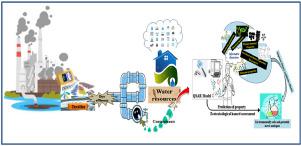Aquatic Toxicology ( IF 4.1 ) Pub Date : 2021-07-23 , DOI: 10.1016/j.aquatox.2021.105925 Gopala Krishna Jillella 1 , Probir Kumar Ojha 2 , Kunal Roy 2

|
The current quantitative structure-activity relationship (QSAR) study seeks to explore the underlying causes of fluctuations in growth rate and biomass of microalgae mainly due to textile dyes. The derived QSAR models cover two endpoints: ErC50 (growth rate) and EbC50 (biomass) of Raphidocelis subcapitata. In order to extract the structural features involved, multiple PLS (partial least squares) models have been developed with easy to interpret and uncomplicated 2D descriptors having proper physico-chemical meaning. These descriptors were calculated from Dragon, SiRMS, and PaDEL-descriptor software. Then, the models were developed initially using stepwise regression followed by partial least squares (PLS) regression, and the model development procedure for both the endpoints (ErC50 and EbC50) followed the stringent Organization for Economic Cooperation and Development (OECD) rules. Later on, the model validation was carried out with statistically significant and internationally accepted metrics (both internally and externally) in both the cases. Next, we have used the “Intelligent Consensus Predictor” tool (available from http://teqip.jdvu.ac.in/QSAR_Tools/DTCLab/) to test the prediction quality with an “intelligent” approach to select multiple models. The estimated prediction quality for the appropriate test sets reveals that the consensus models (CM) surpass the quality shown by individual models (IM) for both the endpoints (ErC50 and EbC50). Finally, the developed models were able to identify the major contributing features (hydrophobic units, unsaturation, saturation, electronegativity, branched atoms and charged fragments) related to aquatic toxicity of textile dyes.
中文翻译:

应用 QSAR 识别关键分子片段并可靠预测纺织染料对 Raphidocelis subcapitata 生长速率和生物量值的影响
当前的定量构效关系(QSAR)研究旨在探讨主要由纺织染料引起的微藻生长速率和生物量波动的根本原因。导出的 QSAR 模型涵盖两个端点: Raphidocelis subcapitata的 E r C 50 (生长率)和 E b C 50 (生物量)。为了提取所涉及的结构特征,我们开发了多个 PLS(偏最小二乘)模型,这些模型具有易于解释且简单的二维描述符,具有适当的物理化学意义。这些描述符是通过 Dragon、SiRMS 和 PaDEL 描述符软件计算得出的。然后,最初使用逐步回归和偏最小二乘 (PLS) 回归来开发模型,并且两个端点(E r C 50和 E b C 50 )的模型开发程序遵循严格的经济合作与发展组织(经合组织)规则。随后,在这两种情况下,使用具有统计意义和国际公认的指标(内部和外部)进行模型验证。接下来,我们使用“智能共识预测器”工具(可从http://teqip.jdvu.ac.in/QSAR_Tools/DTCLab/获得)通过“智能”方法选择多个模型来测试预测质量。适当测试集的估计预测质量表明,共识模型 (CM) 超过了两个端点(E r C 50和 E b C 50 )的单独模型 (IM) 所显示的质量。 最后,开发的模型能够识别与纺织染料水生毒性相关的主要贡献特征(疏水单元、不饱和度、饱和度、电负性、支化原子和带电片段)。











































 京公网安备 11010802027423号
京公网安备 11010802027423号